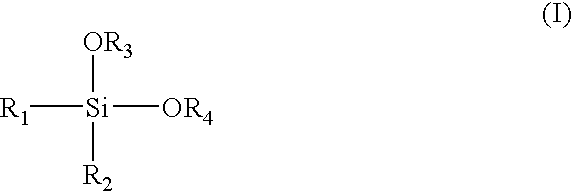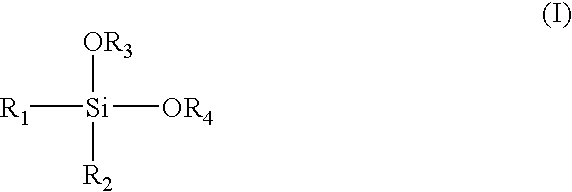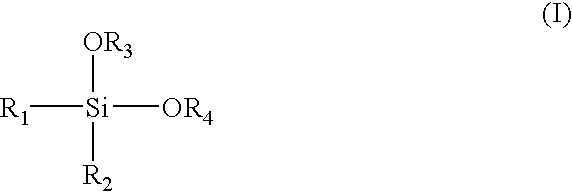Alpha-olefin polymerization catalyst system which contains an aromatic silane compound
a catalyst system and aromatic silane technology, applied in the field of aromatic silane compounds and zieglernatta catalyst systems, can solve problems such as physical properties
- Summary
- Abstract
- Description
- Claims
- Application Information
AI Technical Summary
Benefits of technology
Problems solved by technology
Method used
Image
Examples
example 1
Synthesis of (2-ethylphenyl)-propyl-dimethoxysilane
[0077]A 500 mL round bottomed flask was charged with magnesium turnings (2.73 g, 112 mmol, Aldrich) and ether (300 mL, Aldrich). Bromo-2-ethylbenzene (18.7 mL, 135 mmol, Aldrich) was added over 30 minutes. The reaction stirred for three hours at room temperature and became dark brown in color. The contents were refluxed for one hour.
[0078]The contents were cooled to 0° C. and propyl-trimethoxysilane (19.8 mL, 112 mmol) was added over 25 minutes. The reaction was stirred at room temperature overnight (18 hours) during which time a white precipitate formed. The contents were poured into water (500 mL), the layers separated and the product extracted into ether (3×150 mL). The combined organic portions were dried (MgSO4), filtered and the solvent removed via rotary evaporation providing 28.9 g crude material. Distillation under reduced pressure (b.p. 89° C., 0.7 mm Hg) produced (2-ethylphenyl)-propyl-dimethoxysilane (12.2 g, 51.3 mmol, ...
example 2
Synthesis of (2-ethylphenyl)-3-methylbutyl-dimethoxysilane
[0080]A 1000 mL round bottomed flask was charged with magnesium turnings (1.97 g, 81.0 mmol, Aldrich) and ether (500 mL, Aldrich). Bromo-2-ethylbenzene (14.0 mL, 101 mmol, Aldrich) was added over 30 minutes. The reaction stirred for three hours at room temperature and became dark brown in color. The contents were refluxed for one hour. The contents were cooled to 0° C. and isoamyl-trimethoxysilane (15.9 g, 82.8 mmol, previously prepared by reaction between isoamyl magnesiumbromide and tetramethylortho-silicate) was added over 25 minutes. The reaction was stirred at room temperature overnight (18 hours) during which time a white precipitate formed. The contents were poured into water (500 mL), the layers separated and the product extracted into ether (3×150 mL). The combined organic portions were dried (MgSO4), filtered and the solvent removed via rotary evaporation providing 29.6 g crude material. Distillation under reduced p...
example 3
Synthesis of (2,4-dimethoxyphenyl)-propyl-dimethoxysilane
[0082]A 500 mL round bottomed flask was charged with hexane (200 mL, Aldrich) and bromo-2,4-dimethoxybenzene (12.2 g, 56.0 mmol, Aldrich). The contents were cooled to 0° C. and n-butyl lithium (34.7 mL of a 1.6M solution in hexanes, 55.5 mmol, Aldrich) was added over 15 minutes (white precipitate). The contents were stirred at room temperature for ninety (90) minutes. The solution was added, via cannula, into a 1000 mL round bottomed flask containing hexane (300 mL, Aldrich) and propyl-trimethoxysilane (9.8 mL, 56 mmol). The reaction was stirred at room temperature overnight (18 hours). Ethanol (10 mL, Aldrich) was added to quench residual base. The contents were poured into 0.2N HCl (250 mL). The layers were separated and the product extracted into ether (2×150 mL). The combined organic portions were dried (MgSO4), filtered, and the solvent removed via rotary evaporation (16.2 g crude). Distillation under reduced pressure (b....
PUM
| Property | Measurement | Unit |
|---|---|---|
| Fraction | aaaaa | aaaaa |
| Aromaticity | aaaaa | aaaaa |
Abstract
Description
Claims
Application Information
 Login to View More
Login to View More - R&D
- Intellectual Property
- Life Sciences
- Materials
- Tech Scout
- Unparalleled Data Quality
- Higher Quality Content
- 60% Fewer Hallucinations
Browse by: Latest US Patents, China's latest patents, Technical Efficacy Thesaurus, Application Domain, Technology Topic, Popular Technical Reports.
© 2025 PatSnap. All rights reserved.Legal|Privacy policy|Modern Slavery Act Transparency Statement|Sitemap|About US| Contact US: help@patsnap.com



